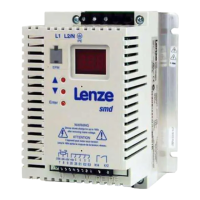20
EDBSV571 EN 1.0
EN
Commissioning
4.5 Parameter Menu
4.5.1 Basic Setup Parameters
Code Possible Settings
IMPORTANT
No. Name Default Selection
P100
Start Control
Source
0 0 Local Keypad Use RUN button on front of drive to start
1 Terminal Strip Use start/stop circuit wired into the terminal
strip. Refer to section 3.2.3
2 Network Only • Start command must come from network
(Modbus, CANopen, etc)
• SMV models <15HP (11kW) require optional
communication module (refer to the
network module documentation).
WARNING!
P100 = 0 disables TB-1 as a STOP input! STOP circuitry may be disabled if parameters
are reset back to defaults (see P199)
NOTE
• The STOP button on the front of the drive is always active except in JOG mode.
• TB-1 is an active STOP input if P100 is set to a value other than 0.
P101
Standard
Reference
Source
0 0 Keypad (Local or Remote) Selects the default speed or torque reference
when no Auto Reference is selected using the
TB-13 input.
1 0-10 VDC
2 4-20 mA
3 Preset #1 (P131)
4 Preset #2 (P132)
5 Preset #3 (P133)
6 Network
7 Preset Sequence Segment #1 (P710) Selections 7, 8 & 9 are not valid for PID
setpoint or torque reference.
8 Preset Sequence Segment #2 (P715)
9 Preset Sequence Segment #3 (P720)
P102
Minimum
Frequency
0.0 0.0 {Hz} P103 • P102,P103areactiveforallspeedreferences
• Whenusingananalogspeedreference,also
see P160, P161
p103
Maximum
Frequency
80.0 7.5 {Hz} 500
NOTE
• P103 cannot be set below Minimum Frequency (P102)
• To set P103 above 120 Hz:
- Scroll up to 120 Hz; display shows HiFr (flashing).
- Release p button and wait one second.
- Press p button again to continue increasing P103.
WARNING!
Consult motor/machine manufacturer before operating above rated frequency. Overspeeding the motor/machine
may cause damage to equipment and injury to personnel!
P104
Acceleration
Time 1
30.0 0.0 {s} 3600 • P104 = time of frequency change from 0 Hz
to P167 (base frequency)
• P105 = time of frequency change from
P167 to 0 Hz
• For S-ramp accel/decel, adjust P106
P105
Deceleration
Time 1
30.0 0.0 {s} 3600
EXAMPLE: IF P103 = 120 Hz, P104 = 20.0 s and P167 (base frequency) = 60 Hz; then the rate of frequency change
from 0 Hz to 120 Hz = 40.0 s
P106
S-Ramp
Integration
Time
0.0 0.0 {s} 50.0 • P106 = 0.0: Linear accel/decel ramp
• P106 > 0.0: Adjusts S-ramp curve for
smoother ramp

